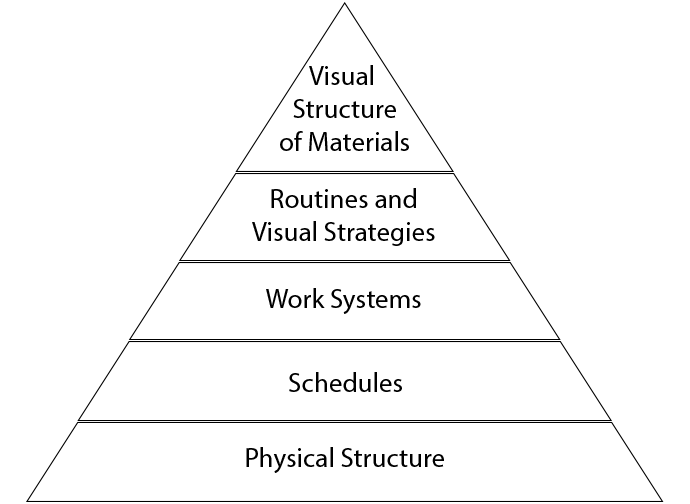This series of four articles can be used as a set or separately depending on the needs of the staff/students. Each article will review the rationale for the use of structured teaching, as well provide as a brief description of the TEACCH model.
Structured Teaching: an overview
Structured Teaching is a set of teaching techniques developed by Division TEACCH (Training and Education of Autistic and related Communication-handicapped Children), a state-wide program serving individuals with autism spectrum disorders (ASD) in North Carolina.
Division TEACCH is a comprehensive treatment model that serves individuals with autism across the lifespan. Along with the structured teaching strategies, the model emphasizes an extensive understanding of autism, partnering with families, individualized assessment when developing and implementing strategies, and the development of skills across curriculum areas (with attention to the development of communication and social skills).
Structured teaching strategies can be implemented across settings and across curriculum area, as they serve as a vehicle to teach skills, and/or as a framework for a classroom setting.
These teaching strategies are based on an understanding of how autism impacts the thinking, learning, and behavior of an individual with ASD. Differences in auditory processing, imitation, motivation, and organization can hinder the educational success of students with ASD, as most traditional teaching strategies rely heavily on verbal instructions, demonstration, social reinforcement, and sequencing chunks of information or directives.
Structured Teaching strategies, however, capitalize on the strengths of students with ASD. These include providing predictable and meaningful routines through the use of structure, adding visual/structural supports to classroom instruction and activities to increase engagement and independence, and clearly organizing classroom spaces and teaching materials to reduce anxiety and increase appropriate behavior.
There are five elements of Structured Teaching that build on one another, and all emphasize the importance of predictability and flexible routines in the classroom setting. Division TEACCH developed a visual to illustrate the Structured Teaching components — the Structured Teaching pyramid:

Article 1: Physical structure in the school setting
This article describes the physical structure component of the Structured Teaching pyramid. Physical structure is the foundation of structured teaching and is helpful in ensuring that learning is occurring in the classroom.
Article 2: Visual schedules in the school setting
This article describes the visual schedule component of the Structured Teaching pyramid. A visual schedule communicates the sequence of upcoming activities or events through the use of objects, photographs, icons, words, or a combination of tangible supports.
Article 3: Work systems in the school setting
This article describes the work systems component of the Structured Teaching pyramid. A work system is an organizational system that gives a student with ASD information about what is expected when he/she arrives at a classroom location.
Article 4: Visual structure in the school setting
This article describes the visual structure component of the Structured Teaching pyramid. Visual structure adds a physical or visual component to tasks to assist students in understanding HOW an activity should be completed.
